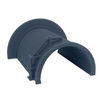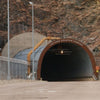NORAD- Cheyenne Mountain Complex - O Scale 1:48
NORAD - Cheyenne Mountain Complex Entrance
O Scale - 1:48
Length 192mm
Width 180mm
Height 102mm
Cheyenne Mountain Complex Quick History and Fun Facts
The North American Air Defense Command (NORAD) was established and activated on September 12, 1957. The Command is a binational organization of Canadian and United States air defense command units, in accordance with NORAD Agreements first made on May 12, 1958. In the late 1950s, a plan was developed to construct a command-and-control center in a hardened facility as a Cold War defensive strategy against long-range Soviet bombers, ballistic missiles, and a nuclear attack. The result was “The Cheyenne Mountain Complex.”
What is the Cheyenne Mountain Complex?
It is a military base and bunker. A self-sustaining city deep inside Cheyenne Mountain, 2000 feet below the surface of the earth. Located outside of Colorado Springs, Colorado in the United States.
Fascinating Facts about the Cheyenne Mountain Complex:
Nuclear Bunkers
The Cheyenne Mountain Complex is one of the United States’ nuclear bunkers. Others include the Raven Rock Mountain Complex, the Mount Weather Emergency Operations Center, and the Deep Underground Command Center.
On September 11, 2001, the secret service moved Vice President Dick Cheney to the bunker under the White House (Presidential Emergency Operations Center) during the attacks.
It was also the most recent time the blast doors were closed except for testing at the Cheyenne Mountain Complex.
Construction
Construction on the Cheyenne Mountain Complex began in 1961, but it wasn’t functional until 1967. Miners excavated 693,000 tons of granite using more than a million pounds of explosives provided by the Canadian government.
In 1962, earth scientists found a geological fault at an intersection. They reinforced the flaw with a colossal concrete dome. When it opened the total cost of the facility was $142.4 million. That is a lot of money, especially in 1967.
Blast Doors
The Cheyenne Mountain Complex has two hydraulic blast doors, 0.914 meters (3-feet) thick, weighing 25 tons each. A 3.22 km (2 mile) tunnel with a 90-degree curve stands between the blast doors and the outside world so anything nuclear will skim the door instead of slamming into it.
They test the doors daily. It only takes forty-five seconds for the hydraulic machinery to swing the giant pistons forward into extensive parallel slots. The doors tighten like a plug, sealing airtight.
If the hydraulics fail, the piston system can operate manually. Using levers, 2 people can close the doors easily by hand by pulling or pushing the pistons open or shut.
Buildings
The Navy constructed the 15 buildings inside the Cheyenne Mountain Complex from battleship steel. They can withstand a 30-megaton nuclear explosion.
The buildings take up almost 4 1/2 acres. The structures are rectangular and range in size from rooms to houses. A series of hallways and ramps connect the buildings. The walkways move free of the structure.
The buildings rest on over 1,300 springs, each weighing over 1,000 pounds. Specifically placed, the buildings are 18 inches from the granite walls so they can move independently in the event of a nuclear blast or a seismic event. They installed countless sections of flexible (bendy) pipe connectors in and under the structures.
Filtered Air
In the event there was an attack, the air in the complex will still be breathable. There is a 20-second delay before outside air enters.
At the push of a button, air enters through blast valves. Then a scrubber strains the air using a filter system built to screen for all chemical, biological, or radioactive agents.
Heating and Cooling
The complex has no furnaces or other heating structures. The cave’s natural temperature stays around 10 to 12.8 degrees Celsius (50 to 55 Fahrenheit).
Four giant chillers help to cool the interior. Two of the chillers are in use at a time with two backup chillers ready in case of breakdowns or maintenance. Inside the fifteen buildings, computers generate heat that keep the buildings around 22.2 degrees Celsius (72 Fahrenheit).
Water
There are four lakes of water within the complex. A single rowboat patrols the lakes. A yellow rubber duck floats on the surface of the lakes as a way for maintenance divers to orientate themselves while submerged. There is a natural spring in the mountain that supplies more water than the base uses.
Generators and Diesel Fuel
The Cheyenne Mountain Complex receives electrical power from Colorado Springs. The backup power system involves six generators and a lake of diesel fuel with a capacity of 1.93 million liters (510,000 gallons). The fuel lagoon floats on top of the water, so the fuel doesn’t seep into the granite. They used the south gateway to fill the reservoir, so gravity pushes the fuel downward.
Fire Department
The complex has its own fire department. The water produced by the mountain springs ensures there will be enough water to put out any size fire.
Besides fighting fires, the firefighters are qualified to execute technical rescues. In their spare time, they practice rappelling skills and first aid drills.
EMP
Inside the complex, they mounted EMP filters on the walls. The metallic oxide varistors prevent a pulse from destroying all the electronic systems inside the complex.
The Cheyenne complex is the only high-altitude facility with that capability.
NORAD
In the last part of the 1960s, the NORAD Combat Operations Center opened inside the complex. At that time, their primary goal was to watch the North America skies for ballistic missiles and air attacks.
Computers
The systems center maintains over 12 million lines of code using 34 separate systems in 27 different languages. Some of their systems never connect to outside networks.
Bolts
In constructing the Hollows, the workers pounded 115,000 rock bolts into the overhead granite. The bolts ranged in length from 1.9 to 9.75 meters (6 to 32 feet).
Adits and Tunnels
The Cheyenne Mountain Complex has three adits. They are horizontal passageways that lead into a mine for access or drainage and help with ventilation. There are miles of tunnels in the seven million cubic feet of hollowed-out space.
Storage Sheds
There are storage sheds, cabinets, and cages located all over the facility filled with equipment. They called these sheds Wal-Marts, stockpiled for easy access in case of an attack or a button-up drill.
Trap Door
To ensure no one could get trapped inside the facility, the Cheyenne Mountain Complex has a built-in fail-safe. In the unlikely event, the other exits are unavailable, there is a tiny trapdoor in the tunnels that offers a crawlspace out of the bunker if you are not claustrophobic.
Movies
Before 9/11 the U.S. government allowed filming within the complex. Films such as War Games and Terminator 3 recorded in parts of the compound, including the command center. Television shows like Stargate SG-1 and Jeremiah also filmed within the facility.
Although not filmed within the complex, video games such as Fallout Tactics: Brotherhood of Steel and Call of Duty: Modern Warfare 2 use the facility as the background of their story's
Working at the Cheyenne Mountain Complex
There is 30 days’ worth of food and supplies for hundreds available at the complex. 350 employees work at the facility with 170 required to stay overnight.
Inside the complex, there is a cafeteria, gym (that doubles as a hospital), dentist, clinic, and a store.
Employees know when they enter the complex if there is a button-up drill or an actual threat, they can’t leave, and no one can enter. As a result, their families would be on their own.









